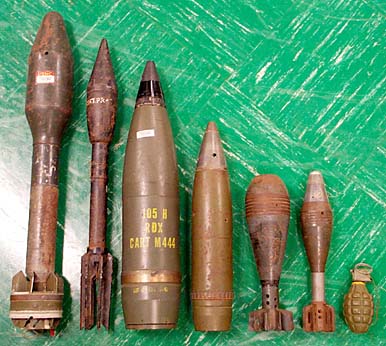
Marines are urged
to clean up WaikaneResidents want the area cleared
of unexploded ordnance
The Marine Corps should clear Waikane Valley of unexploded ordnance now that military officials have decided that the area is too dangerous for jungle survival training, Kahaluu residents and others say.
On Wednesday night, Marine officials announced they were dropping their proposal to use 187 acres for training because of safety concerns about the Windward Oahu land that had been used for live-fire training three decades ago.
The Marines say they do not know what they will do with the land, which the Corps owns, but they still hope to conduct jungle training somewhere in Hawaii.
COURTESY OF THE U.S. MARINE CORPS
As a result of previous Marine Corps training in Waikane Valley, various types of ordnance remain there, including 3.5-inch rockets, 2.36-inch rockets, 105mm HE projectiles, 75mm HE projectiles, 81mm HE mortars, 60mm HE mortars, and MK-2 hand grenades.
Arthur Machado, chairman of the Kahaluu Neighborhood Board, said the board was surprised by the Marines' announcement at Wednesday's board meeting that Waikane is unsuitable. He applauded the decision but noted that a majority of board members said the Marines should clean up the valley.
That sentiment was echoed by others yesterday.
"I'm extremely happy that they're not going to pursue using Waikane for training purposes. I just wish they'd clean it up," said Victoria Holt-Takamine, president of Ilio'ulaokalani, a cultural preservation coalition.
The military said it needed the area to teach Marines how to fight and survive in a jungle. No live ammunition would have been used.
Maj. Chris Hughes, Kaneohe Bay spokesman, said the Marines will spend $800,000 to build a new fence around the property. Construction will begin next month and be completed by summer.
"Just putting up another fence doesn't mean anything to a lot of people," Machado said, since there are still unexploded rockets, grenades and other ordnance that could injure hunters and hikers.
"Kahaluu is known for farming," Machado said. "We are looking to have more farming there ... to grow more taro. ... The feeling of the people here is to go back to the aina."
Hughes said that along with an environmental assessment, which was started 16 months ago, a staff study was initiated to determine what would be needed to transform the area so Marines could return to the valley. It was last used in 1976.
"That included looking at previous records to determine what types of ordnance was used in Waikane," Hughes said. Last week, the Marine Corps determined that there is too much unexploded ordnance in the valley to safely conduct any training.
However, Hughes emphasized that given the need to combat terrorism in places like the Philippines, the Kaneohe Marines need to train somewhere in the state.
"The jungle requirement has not gone away," he said. "We're behind, and we are looking at all the options."
Hughes said the Marine Corps still plans to release a draft of the Waikane environmental assessment next month.
The Marine Corps operates a jungle warfare training center on Okinawa in Japan, which has been used by Kaneohe Marines. "But sometimes there is a year lapse between rotation assignments to Okinawa," Hughes said, and not all Kaneohe Marines get to go there.
Maj. Rob Rouse, director of Kaneohe's environmental compliance and protection department, said there were "no real surprises" uncovered in the draft environmental assessment.
He said there have been two major sweeps of the valley, recovering 24,000 pounds of ordnance debris in 1976 and 16,000 pounds in 1983. No other cleanup has been conducted since then, and no one knows how much ordnance remains.
Chief Warrant Officer Scott Murphy, a Marine Corps ordnance specialist, said rifles, grenades, rockets and 75 mm artillery shells were fired in Waikane since 1940.
Rouse said the Marines' assessment reinforced previous reports that there are no threatened or endangered animals or plants in Waikane, nor are there any critical-habitat issues. Some of the cultural and historical sites found included stone walls and signs of early taro fields.
The Associated Press contributed to this report.
